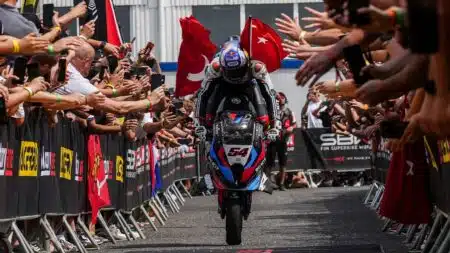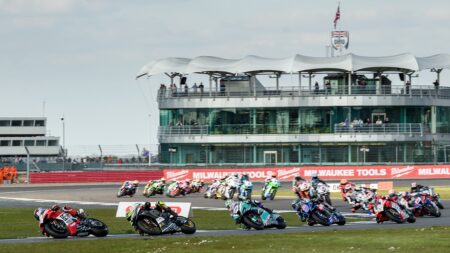
'How racing should be' – Is British Superbikes motor sport's most exciting series?
The 2025 British Superbikes finale is this weekend at Brands Hatch. Is its competition unrivalled? James Elson speaks to some of its top riders to find out
Sunday’s opening superbike round at Phillip Island was interesting in all kinds of ways, but what struck me was where the riders doing the winning had come from.
They certainly weren’t men steeped in the ways of four-stroke production racing from their earliest days. Factory Aprilia riders Eugene Laverty and Sylvain Guintoli – who won a race each on Sunday – did their World Championship apprenticeships on struggle-street in 250 GPs, battling against the odds on ancient machinery.
It’s never much fun seeking out the dispossessed in the GP paddock – you take a long walk to find them, past the gleaming factory team juggernauts, past the glittering hospitality units and there they are at the poor end of pit lane, nursing their bruised talent and looking miserable because they know they are fighting an impossible battle. In fact both Laverty and Guintoli wore brave faces during their early days on the world scene, but that never hid the fact that they worried their talent might never be rewarded with the right machinery.
Laverty did 250 GPs in 2008 and 2009, and it was hard not to feel sorry for him throughout those two seasons when even a top 10 finish was just a crazy dream. In 2008 the Irishman rode an old Aprilia RS250, and when I say old, I don’t mean last year’s, or even the year before that, or the year before that. The Aprilia that Laverty raced against the box-fresh factory bikes of Marco Simoncelli and Alvaro Bautista wasn’t that far off being considered eligible for classic racing. It had been manufactured in 2002!
Guintoli never race anything that ancient, but as a Frenchman he too rode for underfunded teams because ‘bike racing is as much a minority sport in France as it is in Britain. So Guintoli was always over-riding the machinery he had in a vain attempt to bridge the gap to the guys on factory 250s. In 2001 Guintoli and Randy de Puniet were GP rookies and team-mates. Between them they crashed 55 times that summer. “I beat him by one crash!” Guintoli once told me with a huge grin on his face.
Both Guintoli and Laverty found a better life by moving out of GPs, where it’s hard to make it if you’re not Spanish or Italian.
New BMW rider Chaz Davies has ridden the same road, coming to WSB from 250 Grand Prix struggle-street and via World Supersport, like Laverty. Davies spent years on below-par GP machinery, riding for Continental teams who would probably have preferred a Spaniard or an Italian on their bikes. If Davies he had been Spanish or Italian, he would probably have ended up where his current team-mate ended up – on a factory Aprilia 250 and with a 250 World Championship in his pocket.
And this, of course, is why the Moto2 World Championship was created. Through no fault of their own, the 250 class became an Aprilia monopoly. Once Honda and Yamaha got out of 250s (because – oh tragedy – the Japanese stopped making two-strokes) Aprilia effectively decided who got the best bikes and who became World Champion.
Moto2 was supposed to transform MotoGP’s feeder class into a more egalitarian championship, where rider talent would be more important than nationality and money. In particular, Dorna wanted to end the Spanish/Italian duopoly of 250s; not because they feel sorry for the rest of us, but because they want to make MotoGP bigger in countries like Britain and Germany in order to earn more money from selling TV rights. Considering that Stefan Bradl won the second Moto2 series in 2011 and went straight to MotoGP it is tantalising to ponder where Laverty, Davies and Guintoli would be now if Moto2 had existed a decade ago. Might they also be in MotoGP, aboard factory ‘bikes?
But is Moto2 really egalitarian? Its rules were written to make it so: control engines, control tyres, control ECU, control slipper clutch and so on. But racing is never egalitarian. Even in Moto2 some riders and teams have more money than others.
Most people in the paddock reckon that at least three quarters of the riders on the Moto2 grid are paying for their rides, to the tune of several hundred thousand euros each. And the riders with the most sponsorship money tend to get the best rides with the richest teams. And the teams with the most money will always find ways of spending that money to gain an advantage. In Moto2 that means spending more time on the dyno and in the wind tunnel, trying to eke out another few tenths of a horsepower or another few tenths of a mile an hour. It also means trick – and expensive – goodies like ceramic-coated exhaust headers that reduce heat transfer to the radiator, because reducing temperature is the most crucial factor in getting the best from the Honda CBR600 control engine.
So Moto2 isn’t quite as egalitarian as it’s made out to be. But it would be difficult to make it more so without copying the infamous Yamaha RD350LC Pro-Am series of the early 1980s, in which bikes were selected by lucky dip (keys out of a helmet) at the start of each meeting to ensure absolute fairness.
Laverty, Guintoli and Davies got their factory rides in the end, though it’s been a long and winding road for all of them.

The 2025 British Superbikes finale is this weekend at Brands Hatch. Is its competition unrivalled? James Elson speaks to some of its top riders to find out

Toprak Razgatlıoğlu is the most exciting motorcycle racer on Earth right now, so what’s his riding technique and will it work in MotoGP? The Turkish World Superbike genius talks stoppies, breakdancing, riding MotoGP bikes and why he needs engine-brake more than anything

This year’s British GP will feature two BSB Superstock races, with the aim of staging BSB Superbike races in 2025. Plus Silverstone boss reveals what it’s like dealing with Liberty Media, MotoGP’s new owners

Racing is in thrall to the cult of youth but the death, earlier this month, of nine-year-old motorcycle racer Lorenzo Somaschini has prompted Matt Bishop to ask whether higher minimum age limits should be imposed